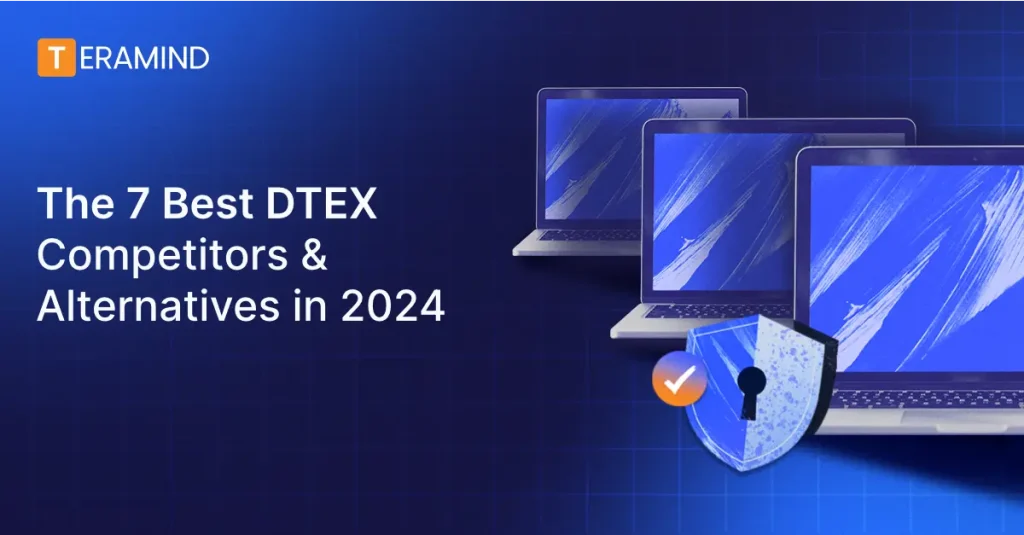In an era where data breaches from malware, insider threats, and cyber attacks loom as significant dangers for organizations, it becomes imperative to establish robust cybersecurity protocols. Data loss prevention (DLP) and insider threat management (ITM) are critical components of this defense strategy.
DTEX Systems, a global leader in insider risk management, offers solutions to detect and mitigate these risks through its DTEX PULSE workforce cyber intelligence solution and DTEX InTERCEPT next-gen insider threat platform powered by user and entity behavior analytics (UEBA). However, despite its advanced analytics capabilities, DTEX may not be the best fit for every organization due to various factors such as cost, deployment complexity, or specific functionality requirements.
Where DTEX Falls Short
While DTEX is a popular choice for security teams aiming to bolster endpoint protection and zero-trust data security, there are some trade-offs to consider:
- DTEX lacks the granular user activity monitoring and surveillance capabilities found in some traditional employee monitoring solutions.
- The solution doesn’t offer preventive features or rule actions to stop threats in real time; it can only detect risks.
- DTEX InTERCEPT primarily emphasizes insider threat detection and user behavior analytics, which means it might offer different comprehensive DLP capabilities than other specialized solutions.
- DTEX, though powerful, can be a costly advanced analytics solution. Its pricing is opaque, and there is no free trial option (unlike Teramind).
In this post, we’ll look in-depth at the best alternatives to DTEX available today that may better meet your organization’s risk tolerance and security requirements. Here are the top 7 DTEX alternatives:
- Teramind
- Code42 Incydr
- ActivTrak
- Forcepoint DLP
- Proofpoint
- Veriato
- Safetica
Teramind
Teramind is a comprehensive employee monitoring and insider threat detection software. It enables organizations to monitor employees’ computer activity, track digital behaviors, and identify potential risks, threats, or policy violations through behavior analytics.
Teramind’s key features include keystroke logging, screen monitoring, file transfer tracking, application and web monitoring, and more. The software also helps companies enforce compliance requirements and prevent data leaks by capturing detailed session recordings that provide a video playback of all user productivity behaviors and actions. This way, companies can gain unparalleled visibility into how employees interact with and utilize company resources and data.
Key Features of Teramind
- It offers comprehensive monitoring, including screen recording, keystroke logging, application monitoring, email monitoring, and remote viewing.
- The advanced DLP features help organizations protect sensitive data and prevent data breaches by monitoring and controlling file transfers, clipboard activities, and content-based rules.
- Teramind helps organizations in highly regulated industries like healthcare maintain compliance with GDPR, HIPAA, PCI DSS, and other regulations by providing audit trails, anomaly detection, and risk-scoring capabilities.
- Provides detailed analytics and reports on employee productivity, including active vs. idle time tracking, project time tracking, and behavior analysis.
Why Teramind is the Best DTEX Alternative
- User-centric security approach with behavior baselining and anomaly detection like DTEX.
- Unlike DTEX, Teramind offers preventive actions, policy enforcement workflows, and automated response capabilities, not just detection.
- Excels in granular activity monitoring and has superior surveillance capabilities.
- Adds content-aware data protection and sensitive data discovery through DLP rules.
What Are Customers Saying About Teramind?
- Excellent product with a wide range of use cases.
- No limits on what you can track!
- The ultimate solution for remote team management
- Excellent for a remote working setup.
Teramind is praised for its comprehensive monitoring features, advanced DLP to stop insider threats and data leaks, and overall ease of use compared to other enterprise security solutions.

Code42 Incydr
Incydr is a cloud-based data security and insider risk management SaaS platform designed to provide visibility, context, and controls to manage data loss and theft caused by insiders, regardless of intent. It aims to help security teams detect and quickly respond to insider risk incidents, such as unauthorized data exfiltration or mishandling of sensitive IP and other critical assets.
Key Features of Incydr
- Uses an endpoint agent to monitor file activity on Windows, Mac, and Linux endpoints and API connections to cloud services and apps.
- Dashboard shows suspicious activity like file sharing and exfiltration outside corporate networks, apps, and endpoints.
- Prioritizes risks by file vectors, user traits, and behavioral anomalies using risk-scoring algorithms to identify real threats from false positives.
Incydr Drawbacks
- Primary focus on insider threats and data exfiltration may not suit all data classification or standard DLP policy violation use cases.
- Cloud-native SaaS deployment may be a drawback for some organizations that prefer on-prem deployments.
- Licensing models and pricing structures for included functionality can be confusing compared to other vendors.
Why Incydr Might Be a Good Alternative to DTEX
Incydr could be a strong DTEX alternative for organizations focused on preventing data breaches and cloud data compromise by insiders. Its file monitoring, prioritized risk scoring, and automated response playbooks provide an advanced solution for data security compared to DTEX InTERCEPT.
ActivTrak
ActivTrak is an employee monitoring and productivity optimization software that tracks work habits, productivity levels, and application usage patterns. It provides insights into how employees spend time on business-critical apps versus non-productive activities.
Key Features of ActivTrak
- Workforce analytics like productivity, workload balance, and technology usage tracking.
- Employee self-monitoring of productivity data and work habits.
- Monitoring of app and website usage for risk mitigation and license optimization.
ActivTrak Drawbacks
- Lacks comprehensive mobile device monitoring for organizations with a significant mobile workforce.
- Provides screenshot capture but no continuous screen recording capability like Teramind.
- Does not support keystroke logging, which some may require for investigation or compliance audits.
Why ActivTrak Might Be a Good Alternative to DTEX
Unlike DTEX’s user-centric security focus, ActivTrak takes more of an IT asset management and employee productivity optimization approach. Its analytics provide visibility into technology adoption, licensing waste, and workforce output – valuable but different from DTEX’s core insider threat management functionality.
Forcepoint DLP
Forcepoint DLP is an advanced data loss prevention solution that provides many features for identifying and protecting sensitive data across various channels, including endpoints, networks, cloud applications, and more.
It offers advanced data protection features powered by machine learning models for data discovery, natural language processing for accurate classification, and precise data fingerprinting techniques.
Key Features of Forcepoint
- Provides holistic data security with extensive DLP coverage across all potential data exposure vectors.
- Identifies and protects PII, PHI, intellectual property, financials, trade secrets, and credit cards.
- Combines risk assessment, automated controls, and user policies to minimize breach risk.
Forcepoint Drawbacks
- Configuring the software and policies can be complex and time-consuming, especially for resource-constrained organizations.
- The machine learning techniques employed by the software require enhancement.
- The pricing model may be higher than other solutions, particularly for organizations with limited budgets or smaller deployments.
Why Forcepoint Might Be a Good Alternative to DTEX
Forcepoint’s extensive coverage across various channels, robust data identification capabilities, and risk-adaptive protection features make it a strong contender. While DTEX focuses on insider threats, Forcepoint prevents data loss incidents across the entire attack surface. Its advanced DLP, compliance support, and enterprise-class capabilities make it a strong option.
Proofpoint
Proofpoint provides cloud-based cybersecurity solutions for email, data security, threat protection, and compliance monitoring across modern SaaS environments. Its ObserveIT insider threat management offering aims to detect and mitigate insider risks.
Key Features of Proofpoint
- Intelligent data classification and real-time DLP across cloud, email, and web channels.
- Pre-built alert library with policies for threats like data exfiltration, privileged abuse, and anomalous system access.
- Prioritized risk scoring based on user behavior insights and anomaly detection.
Proofpoint Drawbacks
- Integrating Proofpoint insider threat management with other security tools like SIEMs can be challenging.
- UI can be cumbersome to navigate.
- Proofpoint’s solutions are comprehensive and complex to deploy and manage, requiring specialized expertise and resources.
Why Proofpoint Might Be a Good Alternative to DTEX
Proofpoint ITM could be a good DTEX alternative for organizations seeking a comprehensive insider threat solution. It offers broader features like DLP, risk scoring, prioritized alerts, an intuitive UI, and a “single pane of glass” approach to streamline threat detection and response compared to DTEX.
Veriato
Veriato is an employee monitoring and insider risk management software that helps organizations boost productivity and protect sensitive data. It provides comprehensive monitoring capabilities, including recording screens, tracking activities, and detecting potential threats in real-time using AI and ML algorithms.
Veriato offers two main products – Vision for user activity monitoring and Cerebral for advanced insider threat management through user behavior analytics (UBA).
Key Features of Veriato
- Veriato’s unique psycholinguistic analysis monitors employee sentiment and flags deviations to identify disengaged or problematic employees.
- Monitors website and app usage, keystrokes, file transfers, documents, and network traffic.
- Admins can set granular policies, and custom alerts for specific activities, keywords, or behavior patterns to enable proactive responses.
Veriato Drawbacks
- The reporting sometimes needs clarity and focuses more on devices than individual users.
- Setting up Veriato, especially on remote machines, can be difficult, and occasional connection issues may arise.
- Some users find the user interface a bit clunky due to its complexity and believe it could be more intuitive.
Why Veriato Might Be a Good Alternative to DTEX
Veriato could be a great alternative for organizations needing comprehensive employee monitoring and insider threat detection. Its granular recording and monitoring capabilities are powerful for investigations and compliance. However, it may have a steeper learning curve and less OS compatibility than other solutions.
Safetica
Safetica is a data-centric security platform offering unified data loss prevention and insider threat management solutions. Their products, Safetica ONE and Safetica NXT, are designed to discover, classify, analyze, and protect sensitive data from accidental or malicious exposure across an organization’s on-prem and cloud infrastructure.
Key Features of Safetica
- Locates and categorizes sensitive data across the organization for adequate data protection and auditing.
- Detailed logging and investigation tools for incident analysis.
- Enforcing data protection policies and auditing assists with industry compliance requirements like GDPR, HIPAA, PCI-DSS, and ISO 27001.
Safetica Drawbacks
- Safetica ONE does not currently support Linux systems, which may be a limitation for organizations using Linux-based infrastructure.
- May generate false positives, flagging legitimate actions as risks.
- Resource-intensive deployment could impact performance in constrained environments.
Why Safetica Might Be a Good Alternative to DTEX
Safetica’s mature data security and governance features are ideal for risk management. Its strengths in data discovery, classification, and protection make it a robust alternative to DTEX for regulatory compliance and comprehensive insider risk coverage across hybrid environments.
Conclusion
Insider threat prevention and user behavior analytics are vital in cybersecurity. While DTEX Systems offers insider risk detection, other solutions such as Teramind, Veriato, Safetica (user monitoring), ActivTrak (workforce analytics), Proofpoint, and Forcepoint (data protection) bring additional capabilities based on use cases, compliance, and budget.
Ultimately, the right DTEX alternative depends on deployment needs, integration, threat detection accuracy, and required security coverage depth. Organizations should carefully evaluate their risk profile and make a purchasing decision aligned with their robust security posture goals.


